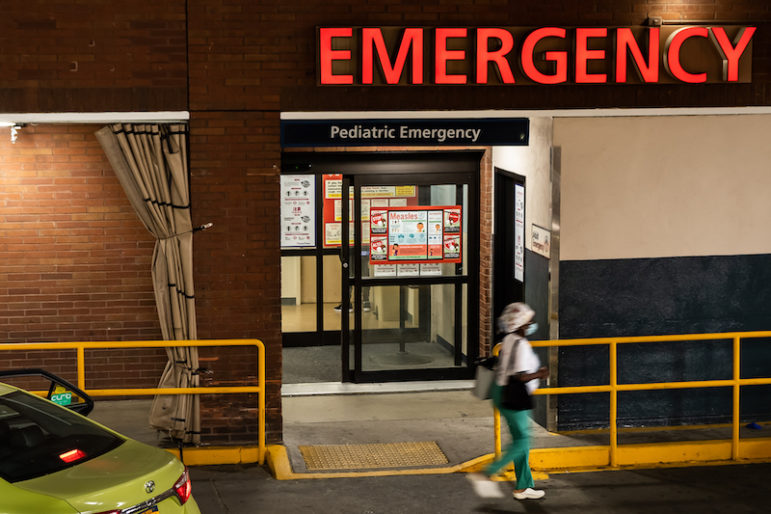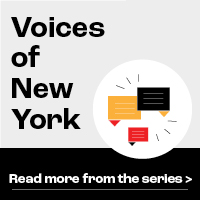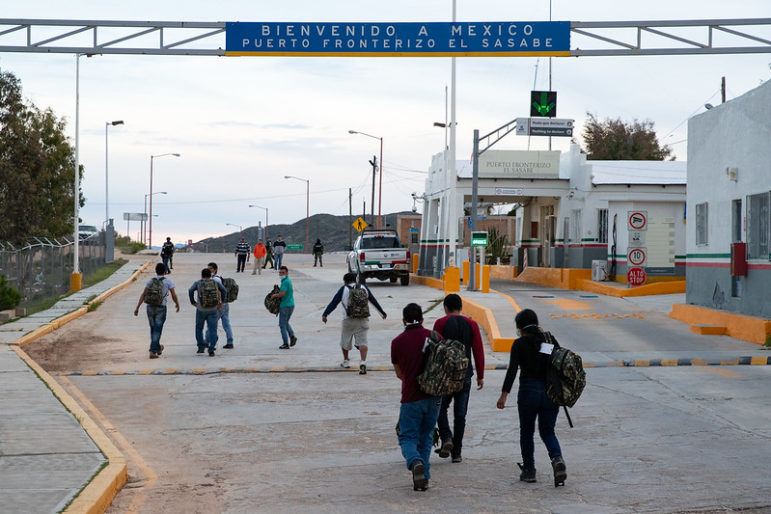Facilities that provided assistance for people with asthma before the pandemic have continued to operate by offering pre-recorded medical advice by phone, and have never returned to in-person services, families told El Diario.

Adi Talwar
The Pediatric Emergency Room entrance at Montefiore Medical Center in the Bronx. The borough has the highest rates of asthma-related emergency room visits and hospitalization in the city, according to the Health Department.This story was originally published by El Diario on Oct. 9, 2021. It was translated for Voices of New York by Carlos Rodriguez, and has been condensed and lightly edited for clarity.
Zaide Cinto has lived in New York for 19 years, ever since she moved from her native Mexico along with her oldest child. In addition to many ills she has endured in the city, including losing her eyesight, she says that asthma has been ever-present in her and her family’s life.
The head of household says that, like her eldest, who is now an adult, her younger children, Maddox, 13, and Bradd, 12, have suffered from asthma since they were babies. She insists that health authorities have disregarded the ailment, or at least “failed to address it with the urgency” it requires. Asthma symptoms include chest tightness, uncontrollable cough, trouble breathing and wheezing upon exhalation.
As the COVID-19 pandemic forced municipal medical services to focus on the virus, Cinto says that other troubling illnesses that for decades have afflicted vulnerable communities such as her South Bronx neighborhood, have been relegated and left unattended.
“I can indeed say that I have fought all my life. Not just against asthma, which my three boys suffer from, but also against the lack of attention, because most hospitals do not take this condition seriously,” says Cinto, adding that the main issue she has faced has been the failure of health clinics to offer real support and provide information about asthma in Spanish, as well as the lack of resources to fight the illness with the same force as the coronavirus.
“I had to learn about asthma by myself the hard way. I suffered a lot with my eldest, and then the next two were also born with it. I cannot see, so I would just hear that horrible cough that keeps them up at night. For years, I took them to the emergency room, only to hear the doctor at the Gouverneur say they were fine, that they did not have anything, until their asthma got worse,” complains Cinto.
“My children could have died. I would just try to get them through it with hot water and VapoRub, because no one ever gave me an inhaler pump to control their asthma attacks,” she says.
The Mexico native added that, in addition to the lack of rigorous medical attention and effective campaigns to educate about asthma, having lived in The Bronx since 2004 also affects her children’s health. Cinto lives near a highway from which excessive car fumes blow in, and many people in her building smoke recklessly.
“I truly think that, although right now they are focusing on the pandemic and not on illnesses such as asthma, the two are related. I believe that they are not doing practically anything about it, and I am speaking for friends and neighbors I know who have similar stories. With the exception of Bellevue Hospital, which is in Manhattan, there is no assistance around here for asthma patients.”
Consuelo Martínez, whose 9- and 11-year-old children are also asthmatic, has the same complaint. She says that, after the pandemic, some places in the city that used to provide assistance for people with asthma have continued to operate by offering pre-recorded medical advice by phone and have never returned to in-person services.
“There is one over on 110th Street where you call and call, and they only give you the option to make appointments for phone consultations. That is useless. I feel that asthmatics are being ignored and that the pandemic has demonstrated that there are many illnesses that cannot be left untreated but actually require twice as much attention,” says the concerned mother. She says that she treats her children with a few refills of salbutamol she was able to save.
While New York City health authorities have recognized that the incidence of asthma is significant, they admit that they have not published full reports on the condition for almost five years. In 2017, they released concerning reports on the rate of asthma cases in the city, which appeared among 158,000 children under 13, with a high proportion of Latinos.
The 2017 report by the Department of Health and Mental Hygiene (DOHMH) revealed that cases such as Cinto and Martínez’s had turned The Bronx into the area with the highest number of asthmatic children in the city, reaching 50,000, or 17.5 percent, of all minors. The paper also listed 39,000 cases in Brooklyn, 37,000 in Queens, 24,000 in Manhattan and 8,000 in Staten Island. The most affected neighborhoods are Hunts Point-Mott Haven, High Bridge-Morrisania, and East Harlem.
Why are Latino children so affected?
Asthma is a long-term, chronic pulmonary disease affecting the patient’s airways. It is unknown exactly how asthma among New York children has evolved since 2017, but the DOHMH recognizes that the condition continues to disproportionately affect Latino and Black children, as well as others living in high poverty areas.
The 2017 report “Health of Latinos in New York City” revealed that over one in six Latino children under 12, and one in four Latinos of high school age, 28 percent, suffered from asthma.
“The Bronx continues to be the most affected borough. Historically, children living in The Bronx have consistently experienced the highest rates of asthma-related emergency room visits and hospitalization, in contrast with the other New York City boroughs,” said Pedro Frisneda, spokesperson for the City’s Department of Health, citing the report.
“While there was a slight decrease in hospitalizations related to asthma during the decade of 2006 to 2016, a marked disparity between The Bronx and other New York City boroughs can still be seen,” said the DOHMH representative.
An analysis carried out last year by New York University’s Furman Center showed The Bronx continues to have the highest numbers of asthma cases in the city, a disease that puts patients at higher risk of suffering serious COVID-19 complications.
“Underlying health conditions may contribute to the difference in mortality rates due to COVID-19. Bronx residents have higher rates of some of the underlying health conditions that place people at greater risk of severe coronavirus cases. Among the five boroughs, The Bronx has by far the highest rates of diabetes and asthma emergency department visits (16% and 242.9 per 10,000 people, respectively.) The Bronx was recently ranked last among the state’s counties in terms of health outcomes, as well as health factors including social, economic, and environmental factors and clinical care.”
Research by Montefiore-Einstein also expressed concern that asthma prevalence reaches 25 percent in some Bronx neighborhoods, and that the borough has the highest rates of hospitalizations and deaths related to asthma in New York.
In an effort to tackle the issue, Montefiore-Einstein announced that they will launch an initiative in 40 public, charter and parochial schools in The Bronx. The community-based approach aims to help children manage their asthma symptoms.
The “Evaluation of the Asthma Management Program to Promote Activity for Students in Schools” (Asthma-PASS) initiative will rely on the participation of 416 children between the ages of 4 and 12. The project will be carried out over five years, and is made possible by a $4.2 million grant from the National Institute of Health to the Albert Einstein College of Medicine and the Children’s Hospital at Montefiore (CHAM.) It seeks to equip children directly with new tools to manage their asthma.
“We developed Asthma-PASS in collaboration with Bronx elementary schools, parents with children with asthma and community members, and then conducted a pilot study in four schools which showed an increase in symptom-free days and children’s physical activity, an important component of asthma management,” said Dr. Marina Reznik, who leads the program. “Our goal with the expanded study is to see if we can reduce asthma symptoms among high-risk urban school children.”
The Asthma-PASS program will include offering workshops about asthma to school staff. Also, an asthma awareness week held at selected schools with events that aim to raise awareness and reduce the stigma associated with the condition.
“During the pilot Asthma-PASS study, we were blown away by the creative ways children learned and shared information about asthma during the awareness week,” said Dr. Reznik. “We hope that all the students participating in the study will find it an engaging and enjoyable way to learn how to better manage their condition and improve their long-term health.”










One thought on “Latino Families Worry COVID-19 Has Sidelined The Bronx’s Asthma Crisis”
I wonder if it’s actually under-diagnosed. If kids only have occasional symptoms, it probably gets missed. How well are parents, caretakers and school staff educated on what to look for? Do medical staff ask kids at checkups if they ever have trouble breathing?
I grew up in the Bronx and I remember being short of breath during track practice when I was in HS. A couple of my teammates who had asthma suggested that I get my slight wheeze checked out. I didn’t tell my parents or my doctor. When I was even younger I also had a particularly bad allergic reaction to a cat and my parent gave me some Vick’s like thing for the severe wheezing. Looking back, I probably should have gotten immediate medical attention.
I had health insurance and access to medical care as a kid, but my known allergies were not really treated (perhaps not much of a specialty in the 80s/90s). It was not until well into adulthood that I finally saw an allergist and subsequently was prescribed an inhaler. Although my asthma is classified as mild, I didn’t realize how bad my breathing was until the allergy treatment started working.
So there should be more awareness and education about asthma (and allergies)
among parents, doctors, school and child care workers and kids themselves.